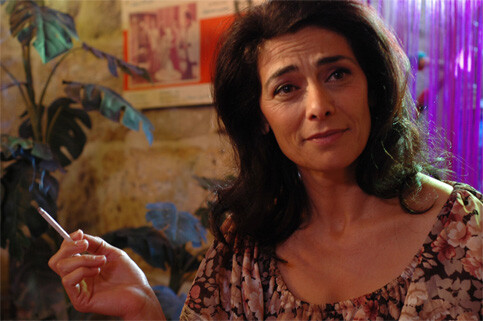The Electronic Intifada 17 March 2010

Hiam Abbas in Pomegranates and Myrrh
Pomegranates and Myrrh is a solid exploration of the walls — internal and external — built up under conditions of extraordinary stress. It’s also about struggle and liberation, both on the personal and political levels. Director Najwa Najjar is a growing talent with her first feature film. The film opens quite conventionally with a surge, perhaps rushed, of upbeat happiness, with one quick hiccup, that even a first-time moviegoer would identify as setting up coming trials. It’s a bit of formula and it doesn’t work particularly well, but it’s one of the film’s few significant missteps. But when it is present, Najjar plays with formula more than conforms to it.
After a celebratory opening of checkpoints and weddings, Ziad (Ashraf Farah), the new groom and olive farmer is taken by soldiers while disputing the confiscation of some of his family’s land. He’s held under administrative detention, leaving the new bride and dancer, Kamar (Yasmine Elmasri), in a rural house with his parents, a disrupted olive harvest and an encroaching Israeli settlement. Comforting her in her period of grief and solitude is Kais (Ali Suliman), a recently arrived choreographer from the refugee camps of Beirut. The film here begins to challenge both the authority of the Israeli occupation, but also the standard bearers in the political and cultural spheres of Palestine. Even as Kais and Kamar struggle with their attraction, they also fight against a status quo that offers just one interpretation of traditional Palestinian dance as well as political resistance.
The significant dance component makes this partially a ballet. Even as some of the less instructive scenes could have been in Fame, the film’s most transcendent moment might well be Kamar’s barefoot flurry on the rocky ground and the ensuing foot care, odd as it might sound. While the choreography is excellent, it is Najjar’s framing of the dancing that makes the scenes interesting. A compelling sequence where Kamar and Kais dance in and out of a darkened frame is as much about dance bringing light as it is the characters’ struggle with their emotions.
As the film moves through Ziad’s imprisonment and struggle for release, the family’s struggle to hold onto its land, and Ziad and Kamar’s struggles with varieties of fidelity, it brings in two characters as plot devices, Umm Habib and Kais. Both are engaging and interesting but are primarily props — welcome props due to dynamite performances — but props nonetheless. Umm Habib — played by a scene-stealing Hiam Abbass — is even abandoned after a stirring confrontation with soldiers during an incursion into Ramallah. Kais is slightly more developed but a large part of his purpose, romantic conflict, is telegraphed from his very first appearance on the screen. Kais is interesting in that his outside intervention is part of the challenge to the political and cultural status quo, but his weariness also serves as a warning of the limitations and dangers of political change.
Najjar captures a strong sense of the land and the built environment. She frames Ramallah marvelously, creatively showing the back-and-forth struggle between enforced order and unplanned chaos. Familiar landmarks like the lions of al-Manara Square are reinvented in their symbolism. The wet and dry, but coherent, streets of Ramallah are counterposed twice, against the broken urban geography of the Ramallah-Jerusalem frontier where Israels wall divides the contiguous metropolis with Jerusalemites like Kamar and her family on one side and “West Bankers” like Ziad on the other. Najjar also contrast Ramallahs streets with the stony hills of the middle of the West Bank where Ziad’s family holds and harvests their olive orchards.
The physical environment is as important a character in the film as any of the individuals. The story is largely one of a personal drama of love and distance, agricultural life and rebellion. But in the built environment one finds the more difficult context of life under occupation. The fences and walls barricading the land that Israeli settlers are attempting to steal, the blocks and fences at checkpoints, the wall and, most strikingly, the doors, windows, walls and fences at the prison all present the occupation as a physical barrier to plans both large and small. The next year’s harvest will be increasingly difficult should the settler’s erected fences remain. The caged windows at the prison prevent anything but the most superficial expressions of physical love. And what will checkpoints do to wedding plans? The occupation functions also as a metaphor for all Kamar’s internal walls as she challenges her position as wife, expands traditional interpretations of dance and struggles to assert her identity as more than the wife of a prisoner.
Casual viewers will be challenged by the film as outsiders would be to any “inside” story. If one knows little or nothing about the walls, checkpoints, settlements and the occupation some of the context will be difficult to interpret. Terms like “administrative detention” are not defined which would lead to confusion for those not familiar with the occupation. But this is what makes it a Palestinian film. This is where the film contrasts with a more renowned film like Paradise Now. While Paradise Now has a level of exposition for a broader audience, to whom the particulars of the occupation and political debates may not be well known, Pomegranates & Myrrh is a good film with significant payoffs for viewers informed or casual. But Palestinian viewers, or those intimate to the country and the conflict that consumes it, are going to get a lot more out of it. And that’s probably the way it should be.
Editor’s note: This review originally reported that Pomegranates and Myrrh is director Najwa Najjar’s third feature film. This version of the review is corrected to reflect that it is her first.
Jimmy Johnson is a supermarket employee in southeast Michigan and can be reached at johnson [dot] jimmy [at] gmail [dot] com.



